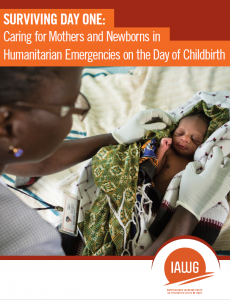
The United Nations Office for the Coordination of Humanitarian Affairs (UNOCHA) estimates that nearly 132 million people living in 42 countries will need humanitarian assistance in 2019. Even more alarming, women and children suffer disproportionately in humanitarian emergencies. Though investment in reproductive health in humanitarian emergencies has increased in recent years, focus on care for the mother-baby dyad during childbirth remains inadequate. Globally, of the ten countries with the worst neonatal mortality rate, five are in humanitarian emergencies: Afghanistan, Somalia, South Sudan, Central African Republic, and Chad. Moreover, all have a neonatal mortality rate above 30 deaths per 1000 live births. Reducing maternal and newborn mortality requires the improvement of access to and quality of comprehensive sexual, reproductive services, skilled care during labor and childbirth, and access to quality emergency obstetric and newborn care. While progress has been made in financing and delivering reproductive health in crisis settings, significant gaps remain in the provision of essential and emergency obstetric and newborn care. As humanitarian contexts continue to become more complex, with an increased number of displaced persons and protracted settings as reported by UNHCR, more strategic action is needed to reduce preventable maternal and newborn deaths and stillbirths.
Reaching women and newborns with safe, quality, respectful care on the day of childbirth and during the first week of life is the most effective way to reduce both maternal and neonatal deaths. The recently updated Minimum Initial Service Package for Reproductive Health (MISP), the Inter-Agency Field Manual on Reproductive Health in Humanitarian Settings and the Newborn Health in Humanitarian Settings: Field Guide emphasize the importance of quality care on the day of childbirth for mothers and newborns including essential newborn care, and care for small and sick newborns. The World Health Organization’s Every Newborn Action Plan and Strategies Toward Ending Preventable Maternal Mortality documents clearly outline how to reduce preventable deaths and improve maternal and newborn health globally. However, various barriers prevent us from meeting this need, especially in humanitarian emergencies, which have become increasingly complex. These challenges include siloed approaches to maternal and newborn health, limited availability of skilled birth attendants, lack of essential commodities, low uptake of services by women and delayed access to comprehensive emergency obstetric and neonatal care.
Ensuring women and newborns are provided quality, respectful, timely and effective care, particularly in the hardest to reach places, requires collective action. To achieve this vision, we call on countries, donors, implementing organizations and global policymakers to mobilize around three key actions:
- Intensify preparedness and resilience building efforts focused on maternal and newborn health
- Prioritize integrated maternal and newborn life-saving interventions in crisis settings
- Amplify the role of communities in the delivery of maternal and newborn health interventions, recognizing they are both the immediate and long-term responders
The priorities and recommendations highlighted in this paper are the product of consultations with members of the IAWG Maternal and Newborn Health Sub-Working Group, participants at the 2019 Newborn Strategy Experts Meeting held in Geneva, and inputs from international NGO field staff, local NGO staff in Bangladesh, UN representatives and donors.